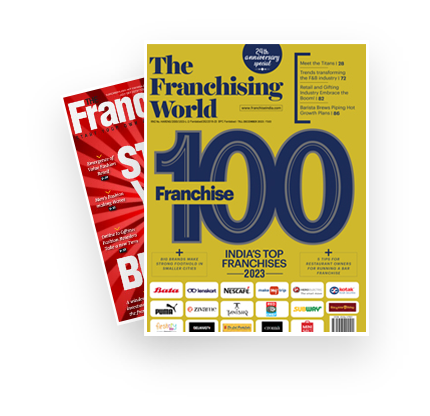
Imagine you have been thinking about starting your own home-based internet clothes business. Perhaps you have a sense of style, or perhaps you're simply sick of working 9 to 5. In any case, I can assure you that it is not only feasible but also quite thrilling! These days, you don't need lakhs of rupees or a beautiful studio to get started. All you need is a solid plan, a little creativity, and the courage to keep going. Don’t stress yourself, this is a comprehensive guide to building your online clothing business from the comfort of your home.
Why an online clothing business from home?
The size of the online fashion market in India was valued at US$21.60 billion in 2025 and is projected to expand at a compound annual growth rate (CAGR) of 24.2% from 2025 to 2032, reaching US$98.45 billion. It is projected that the apparel market in India would increase from USD 120.36 billion in 2025 to USD 171.60 billion by 2034.
Also Read: Poultry Egg Farming Business Plan: Detailed Guide
With the growing e-commerce sector, starting a home-based online clothes business can be rewarding and successful. There is no denying the appeal of creating a fashion brand from home. It is a desirable choice for prospective business owners due to its low expenses, flexible scheduling, and direct client interaction. It's no longer a side gig to start an online clothes business from home; it's a full-fledged opportunity to make money off of your ideas. Starting your own clothing line online has never been easier, more affordable, or more scalable, regardless of your background—fashion enthusiast, homemaker hoping to establish a brand, or student looking to supplement your income.
Here are the key reasons why it's a smart move:
Low Overhead and Startup Costs
- Not having to pay commercial rent is possibly the largest savings. The high monthly rent, security deposits, and property taxes that come with renting a physical shop location are eliminated.
- Recurring costs will be further reduced because you won't have to pay separate fees for internet, water, or energy for a commercial location.
- You can handle nearly everything on your own in the beginning, saving money on sales associate salaries. It's scalable, but you may need to add part-time workers or freelancers as your business expands.
- Print-on-Demand (POD) and dropshipping are two business methods that let you begin with almost little inventory. The danger of unsold stock and front capital expenditure is significantly reduced because products are only manufactured or dispatched when a buyer places an order. Even if you decide to keep some goods, you're not hiring a warehouse; rather, you're using existing space.
Unparalleled Work-Life Balance and Flexibility
- Decide on Your Hours: You are free to work whenever it is most convenient for you, including early in the morning, late at night, or around obligations to your family. For parents, students, or anyone seeking a side gig, this is especially alluring.
- Work From Anywhere: You can run your online store from anywhere in the world as long as you have an internet connection. This provides amazing freedom in terms of lifestyle.
- Scalability: Growing a firm online is significantly simpler. Without having to relocate to a bigger physical store, you can handle higher sales, add additional products, and enhance your marketing efforts.
Wider Reach and Global Market Access
- Availability: Your online store is accessible 24 hours a day, seven days a week. Regardless of time zones, customers can browse and buy whenever it is most convenient for them.
- Global Customers: An internet store has a wider customer base than a neighborhood boutique. Your potential market might be greatly increased by reaching clients both domestically and abroad.
- Targeted Marketing: Using demographics, interests, and online activity, online platforms provide advanced capabilities to help you target your ideal clients. This makes it possible for marketing campaigns to be extremely successful and efficient.
Also Read: Top 5 Horticulture Business Ideas in India 2025
Creative Control and Brand Building
- Complete Creative Freedom: You are in total control of your marketing messaging, product choices, designs, and brand identification. This enables you to communicate your distinct vision free from outside disturbance.
- Authentic Brand Story: You can establish a stronger bond with your audience by incorporating your beliefs and personal narrative into your brand. Modern customers place a high value on this genuineness.
- Niche Specialization: Due to low local demand, it may be difficult to serve very specialized niches in a physical store, but doing so online makes it easier.

Step-by-Step Guide to Start Your Online Clothing Business
This comprehensive guide will shed light on the process of starting and growing your own online clothes business.
Creating the Framework: Planning and Choosing a Niche
Being everything to everyone is impossible. You may stand out and develop an enthusiastic following by focusing on a smaller expertise. A clear vision and careful planning are essential for the success of your online clothes business. This is the foundation around which your brand will be formed, so don't rush it.
Some niche ideas:
- Ethnic wear (sarees, kurtis)
- Kids’ fashion
- Plus-size clothing
- Sustainable fashion
- Streetwear or casualwear
- Gym and athleisure wear
What Do You Know About the Market?
A successful business requires thorough market research to know what you are getting yourself into. You may better grasp consumer preferences and validate your specialty with the help of market research.
Also Read: Bamboo Farming Business in India: Process, Investment, and Profit
What has to be explored:
- Who are your rivals?
- How much do they charge?
- Which materials and styles are in vogue?
- Which websites—Amazon, Myntra, Shopify, Instagram
Analyze trends and comments using free resources such as Google Trends, Instagram hashtags, and Amazon reviews.
Decide Your Business Model
When launching a home-based clothing business, there are three main models to consider:
a) Make-and-Sell (Do It Yourself):
- You create and stitch your own items.
- Increased quality control
- Requires sewing abilities and supplies
b) Buy-and-Resell:
- You purchase in large quantities from manufacturers or wholesalers.
- Repackage, then market under your own name.
- Perfect for rapid fashion or ethnic styles.
c) Print-on-Demand or Dropshipping:
- Collaborate with print-on-demand businesses (such as Printrove and Qikink in India).
- They print and send what you create.
- No inventory is needed.
Source Products or Raw Materials
Based on your model:
- Visit wholesale textile markets such as Tirupur (Tamil Nadu), Gandhi Nagar (Delhi), or Surat Textile Market.
- Look for trustworthy partners for print-on-demand or dropshipping.
- For higher margins, buy fabric and sewing supplies in bulk if you're doing it yourself.
- Make sure your provider has return policies, prompt delivery, and high-quality products.
Also Read: Pearl Farming in India – Process and Investment Cost
Branding: Name, Packaging, and Logo
- The tone of your clothing line is established by your brand identification. It should appeal to your audience and represent your niche.
- Choose a catchy name by checking the availability of the domain and Instagram.
- Create a polished logo with Canva or Fiverr.
- Consider using beautiful or eco-friendly packaging; it adds value!
Pro Tip: Write a brief narrative about your brand. Consumers enjoy relating to brands that provide a purpose.

Set Up Your Online Store
There are multiple platforms to sell your clothing line:
a) E-commerce Website:
- Make use of WooCommerce, Wix, or Shopify.
- It gives you total control over your branding.
b) Online Marketplaces:
- Etsy (for antique and handmade goods), Amazon, Flipkart, and Meesho.
- Starting is simple, but branding control is limited.
c) Social Media Storefront:
- Facebook Marketplace and Instagram Shop
- Excellent for organic promotion and very graphic
Don't skip: Include comprehensive product descriptions, sizing charts, a return policy, and excellent photos.
Also Read: How to Make a Profitable Hydroponic Farming Business Plan?
Inventory and Order Completion
How to handle inventories at home:
- Make use of storage boxes and racks with labels.
- Utilize inventory software or keep a simple stock spreadsheet.
- When dropshipping, inventory is managed by the supplier.
To complete orders:
- Join hands with courier partners such as India Post, Pickrr, or Shiprocket.
- Provide cash on delivery (COD) to foster confidence, particularly in the beginning.
Promotion and Marketing
Even the best products require exposure.
- Important Marketing Strategies: Instagram marketing using stories, influencers, and reels.
- Google Ads & Facebook: For targeted traffic
- WhatsApp Marketing: Make use of broadcast lists or groups
- Email Campaigns: For offers and updates, use programs like Mailchimp.
- YouTube or an SEO blog: For consistent traffic
Start small, scale after testing what works.
Business & Legal Registrations
To maintain compliance for your company:
- Sign up as a sole proprietor (or partnership/LLP if you're working with someone else).
- Apply for GST registration if you sell on marketplaces or have a revenue of more than ₹20 lakhs.
- Obtain a PAN and a current account under your own name.
- Trademarking your brand name and logo is advised but not required.
- Websites such as Vakilsearch and IndiaFilings can assist you with setting up at a reasonable cost.
Investment Breakdown: Starting an Online Clothing Business from Home
Here’s a rough idea of the minimum budget required:
| Item | Estimated Cost (₹) |
|---|---|
| Raw Materials or Sample Stock | 10,000 – 20,000 |
| Logo & Branding | 1,000 – 3,000 |
| Product Photography (DIY setup) | 2,000 – 4,000 |
| Website (Shopify or Hosting Plan) | 2,000 – 6,000 |
| Packaging Materials | 2,000 – 5,000 |
| Marketing (initial ads/influencers) | 5,000 – 10,000 |
| Business Registration & GST | 2,000 – 5,000 |
| Total Estimated Investment | ₹25,000 – ₹50,000 |
It takes a combination of imagination, perseverance, and smart planning to launch a home-based online clothing business. Even if it might not make you a millionaire right away, you can create a brand that appeals to thousands of people with the correct product and positioning. What's the best part? To get started, all you need is patience, enthusiasm, and a clear goal. Therefore, there is a genuine and ready potential to sell Surat sarees, Jaipur cotton kurtis, or Gen Z custom-printed t-shirts.

